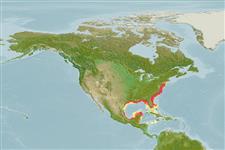>
Clupeiformes (Herrings) >
Engraulidae (Anchovies) > Engraulinae
Etymology: Anchoa: Italian ancioa = anchovy (Ref. 45335).
Eponymy: Dr Samuel Latham Mitchill (1764–1831) was an American physician, naturalist and politician. [...] (Ref. 128868), visit book page.
More on author: Valenciennes.
Environment: milieu / climate zone / depth range / distribution range
Ecologie
marien; zoet water; brak water; amfidroom (Ref. 51243); diepte 1 - 70 m (Ref. 93252), usually 1 - 36 m (Ref. 189). Subtropical; 42°N - 16°N, 99°W - 72°W (Ref. 189)
Western Atlantic: Casco Bay, Maine south to Florida Keys and westward around the Gulf of Mexico south to Yucatán; not in the West Indies.
Lengte bij maturiteit / Grootte / Gewicht / Leeftijd
Maturity: Lm 4.3, range 4 - 4.5 cm
Max length : 10.0 cm SL mannelijk / geslacht onbekend; (Ref. 189); common length : 6.0 cm TL mannelijk / geslacht onbekend; (Ref. 12193)
Dorsale stekels (totaal) : 0; Dorsale zachte stralen (totaal) : 0; Anale stekels: 0; Anale zachte stralen: 23 - 31. Body variable, more slender in northern populations. Snout fairly blunt, a little over 1/2 eye diameter; maxilla long, tip pointed, reaching beyond hind border of pre-operculum, almost to gill opening; panamensis-type gill cover canals. Anal fin rays rarely 28, its origin below unbranched dorsal fin rays. Anus nearer to pelvic fin tips than to anal fin origin.
More commonly found in shallow tidal areas with muddy bottoms and brackish waters, tolerating a wide range of salinities (virtually fresh to fully saline or hypersaline). Found only in spring and summer in the tidal portion of the Ochlockonee River, Florida. Feed mostly on Mysis and copepods, also small fishes, gastropods and isopods. Breed off North Carolina from late April to mid-July, perhaps through to August. Used to some extent to make anchovy paste (Ref. 189).
Spawn in school (Ref. 205).
Whitehead, P.J.P., G.J. Nelson and T. Wongratana, 1988. FAO Species Catalogue. Vol. 7. Clupeoid fishes of the world (Suborder Clupeoidei). An annotated and illustrated catalogue of the herrings, sardines, pilchards, sprats, shads, anchovies and wolf-herrings. FAO Fish. Synop. 125(7/2):305-579. Rome: FAO. (Ref. 189)
Status op de Rode Lijst van het IUCN (Ref. 130435: Version 2024-1)
Gevaar voor de mens
Harmless
Gebruik door de mens
Visserij: van minder commercieel belang; aas: usually
Tools
Speciale rapporten
Download XML
Internetbronnen
Estimates based on models
Preferred temperature (Ref.
123201): 13.2 - 26.9, mean 24 °C (based on 432 cells).
Fylogenetische diversiteitsindex (Ref.
82804): PD
50 = 0.5000 [Uniqueness, from 0.5 = low to 2.0 = high].
Bayesian length-weight: a=0.00589 (0.00475 - 0.00730), b=3.16 (3.12 - 3.20), in cm total length, based on LWR estimates for this species (Ref.
93245).
Trofisch niveau (Ref.
69278): 3.3 ±0.33 se; based on food items.
Weerstandsvermogen (Ref.
120179): Hoog, minimale populatieverdubbelingstijd minder dan 15 maanden (K>0.30; tmax=3).
Fishing Vulnerability (Ref.
59153): Low to moderate vulnerability (31 of 100).
Climate Vulnerability (Ref.
125649): Moderate to high vulnerability (50 of 100).
Nutrients (Ref.
124155): Calcium = 204 [126, 469] mg/100g; Iron = 1.83 [1.02, 3.40] mg/100g; Protein = 17.8 [15.4, 20.5] %; Omega3 = 0.543 [0.295, 1.019] g/100g; Selenium = 15.6 [7.4, 36.6] μg/100g; VitaminA = 28.9 [9.4, 78.9] μg/100g; Zinc = 1.42 [0.97, 2.19] mg/100g (wet weight);
